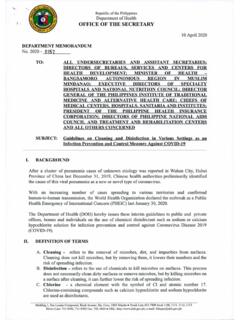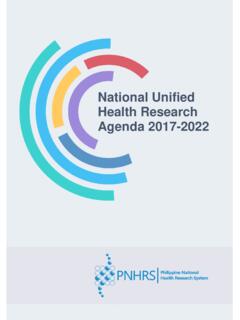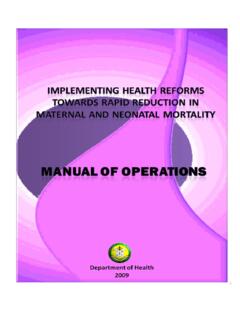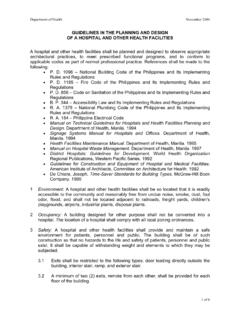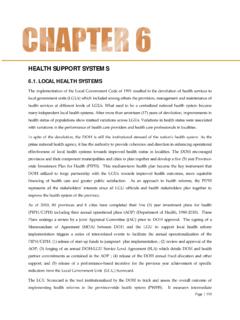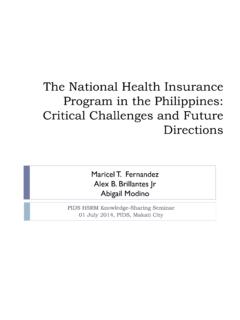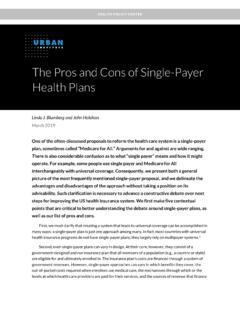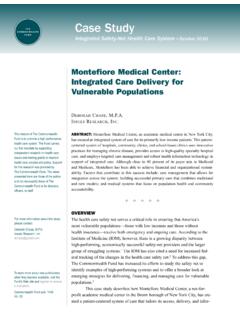Transcription of THE PHILIPPINE HEALTH SYSTEM AT A GLANCE
1 THE PHILIPPINE HEALTH SYSTEM AT A GLANCE . HEALTH financing . The HEALTH financing SYSTEM in the country is complex as it involves different layers of financial sources, regulatory bodies and HEALTH service providers. Figure 1 shows the financing flows for HEALTH as to sources and uses. In general, there are four main sources of financing : (1) national and local government, (2). insurance (government and private), (3) user fees/out of pocket and (4) donors. FIGURE 1. HEALTH financing FLOW, PHILIPPINES. Source: HSRA Monograph on HEALTH Care financing , Department of HEALTH In 1995, the national HEALTH insurance Program (NHIP) managed by PHILIPPINE HEALTH insurance Corporation (PHIC or PhilHealth) was institutionalized and signaled the movement towards a single - payer premium-based financing or insurance SYSTEM .
2 However, the current SYSTEM continues to maintain a dual financing SYSTEM existing parallel to each other. The total HEALTH expenditure increased from Php 87 Billion in 1995 to almost Php 225 Billion in 2007. ( national Statistical Coordination Board, 2007). Although there is an increase in the total HEALTH expenditure in nominal terms, its share on the GDP is still at to percent ( national Statistical Coordination Board, 2007 ). Figure 2 shows the share of different HEALTH financial sources. Out of pocket has the largest share of Page | 3. the total HEALTH expenditure. Despite the safety nets like NHIP, the share of out of pocket expenditure increased from 47 percent in 1997 to 57 percent in 2007 ( national Statistical Coordination Board, 2007 ).
3 The share of local and national government subsidy also decreased on the same period. FIGURE 2. TOTAL HEALTH EXPENDITURE BY SOURCE, PHILIPPINES, 1997 AND 2007. 1997 2007. Source: PHILIPPINE national HEALTH Accounts, NSCB. The high level of out of pocket may lead to financial catastrophe and impoverishment. Table 2 validates the large contribution of out of pocket during healthcare seeking episodes. Majority of patients from both public and private utilize out of pocket during confinement but it is significantly higher among patients confined in public facilities. Despite the presence of safety nets, donations (from philanthropists and charity organizations) would still count as one of the major sources of financing (Lavado and Ulep, 2011).
4 TABLE 2. SOURCE OF financing DURING INPATIENT VISITS, PHILIPPINES, 2008. Confined in Private Hospitals Confined in Public Facilities Sources of Payment (%) (%). Salary/Income 48 51. Loan 17 23. Savings 37 32. Donation 17 23. PhilHealth 51 24. SSS/GSIS 4 2. HMO 6 1. Others Source: Raw data from national Demographic and HEALTH Survey, NSO 2008. Looking at the components of out-of-pocket by quintile, more than half of the medical expenditure was spent on medicine. However, share of medicine on the total medical expenditure was consistently higher among the poor compared to their richer counterparts.
5 Expenditure on contraceptives was also higher among the poor household (Lavado and Ulep, 2011). Page | 4. TABLE OF OUT-OF POCKET EXPENDITURE BY COMPONENTS AND BY SOCIO- ECONOMIC STATUS, IN PERCENT, PHILIPPINES. 2000-2009. Components Poorest Richest Philippines 2000 2003 2006 2009 2000 2003 2006 2009 2000 2003 2006 2009. Medicines Hospital Charges Medical and Dental Other Medical Goods Other Medical Services Contraceptive Food Supplement Source: Raw data Family Income and Expenditure Surveys, 2000-2009. HEALTH CARE DELIVERY SYSTEM . The PHILIPPINE HEALTH care SYSTEM has rapidly evolved with many challenges through time.
6 HEALTH service delivery was devolved to the Local Government Units (LGUs) in 1991, and for many reasons, it has not completely surmounted the fragmentation issue. HEALTH human resource struggles with the problems of underemployment, scarcity and skewed distribution. There is a strong involvement of the private sector comprising 50% of the HEALTH SYSTEM but regulatory functions of the government have yet to be fully maximized. HEALTH Facilities HEALTH facilities in the Philippines include government hospitals, private hospitals and primary HEALTH care facilities. Hospitals are classified based on ownership as public or private hospitals.
7 In the Philippines, around 40 percent of hospitals are public (Department of HEALTH , 2009). Out of 721 public hospitals, 70 are managed by the DOH while the remaining hospitals are managed by LGUs and other national government agencies (Department of HEALTH , 2009). Both public and private hospitals can also be classified by the service capability (see DOH AO 2005-0029). A new classification and licensing SYSTEM will soon be adopted to respond to the capacity gaps of existing HEALTH facilities in all levels. At present, Level-1. hospitals account for almost 56 percent of the total number of hospitals (Department of HEALTH , 2009.)
8 Lavado, 2010) which have very limited capacity, comparable only to infirmaries. Page | 5. FIGURE 3. NUMBER OF HOSPITALS BY CLASSIFICATION. AND OWNERSHIP, PHILIPPINES, 2009. Figure 3 shows that the private 1200. 70 hospitals outnumbered the government 1000. 183 hospitals in all categories. The disparity 800 50. Number 38 is more noticeable in tertiary hospitals 600. 405 where the number of private hospitals is 271. 400. four times that of the government 200. 362 417 hospitals. 0. Government Private Level 1 Level 2 Level 3 Level 4. Source of Raw Data: List of Hospitals and Other Facilities, BHFS-DOH.
9 Figure 4 shows the distribution of hospitals by level. Levels 1 and 2 hospitals are relatively well-distributed across the country (though there are few provinces with limited level 2). However, hospitals with higher service capabilities are highly concentrated in Region 3 and national Capital Region (NCR) (Lavado, 2010). FIGURE 4. DISTRIBUTION OF HOSPITALS BY LEVEL AND GEOGRAPHICAL DISTRIBUTION, PHILIPPINES, 2009. Level 1 Level 2 Level 3 Level 4. Source of Raw Data: List of Hospitals and Other Facilities, BHFS-DOH. The number of hospital beds is also a good indicator of HEALTH service availability.
10 Per WHO. recommendation, there should be 20 hospital beds per 10,000 population. Table 4 describes the Page | 6. distribution of private and public hospital beds by region. Almost all regions have insufficient beds relative to the population except for NCR, Northern Mindanao, Southern Mindanao and CAR. Among the seventeen regions, Autonomous Region for Muslim Mindanao (ARMM) has the lowest bed to population ratio ( beds per 1000 population), far lower than the national average. TABLE 4. NUMBER OF BEDS AND RATE PER 1000 POPULATION BY REGION, PHILIPPINES, 2008. Region Number of beds Rate per 1000 population Ilocos Region 4163 Cagayan Valley 2779 Central Luzon 8218 Region IV-A (CALABARZON) 9459 Region IV-B (MIMAROPA) 2093 Bicol Region 4156 Western Visayas 5714 Central Visayas 6190 Eastern Visayas 2845 Zamboanga Peninsula 2909 Northern Mindanao 4858 Southern Mindanao 4580 Central Mindanao 3680 NCR 27779 CAR 2472 ARMM 586 CARAGA 1718 Philippines 94199 Source.
